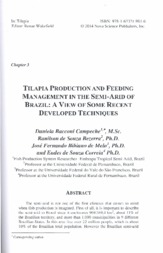Tilapia production and feeding management in the semi-arid of brazil: a view of some recent developed techniques.
Tilapia production and feeding management in the semi-arid of brazil: a view of some recent developed techniques.
Author(s): CAMPECHE, D. F. B.; BEZERRA, R. de S.; MELO, J. F. B. de; CORREIA, E. de S.
Summary: The Semi-Arid is not one of the first climates that comes to mind when fish production is imagined. First of all, it is important to describe the semi-arid in Brazil since it enclosures 969.589,4 km2, about 11% of the Brazilian territory, and more than 1.000 municipalities in 9 different Brazilian States. In this area live over 22 million people, which is about 10% of the Brazilian total population. However the Brazilian semi-arid has some particular characteristics that made it possible.The São Francisco River and large water reservoirs such as Castanhão and Orós are some of the water bodies where tilapia culture has been sucessfull. There are several production systems adopted ranging from tilapia in irrigation reservoirs on small rural properties to intensive cage culture. It does not matter which production system was adopted by the producer, since the area is semi-arid the water quality has to be extremely well managed and cared for in order to preserve it and guarantee the highest possible productivity per cubic meter of water. ln order to achieve the best productivity, some management practices must be adopted. One of them is to select the best variety for breending. Several tilapia varieties have been introduced into the Brazilian semi-arid since the 1970's. However Tai tilapia has been the most successful and is cultivated nowadays. Red Koina and Saint Peters have also been introduced, but it did not succeed due to their low growth after 400g. Tilapia GIFT has already been tested in cage culture. The results are promising, but there is a lack of farrns to produce this variety in the Brazilian semi-arid. Tilapia feeding management is an important issue in tilapia culture in this region. Feeding practices may differ from areas within the semi-arid as well as production systems. Several local ingredients have been tested as examples mango meal, cassava chips and leucaena hay. Most of them are used by small producers as tilapia feed complement. Cage culture producers are well instructed to only use balanced extruded feed in order to achieve better growth and maintain the best possible water quality.
Publication year: 2014
Types of publication: Book sections
Unit: Embrapa Semi-arid Region
Keywords: Aquicultura, Consumo humano, Manejo alimentar, Peixe, Produção, Tilapia
Observation
Some of Embrapa's publications are published as ePub files. To read them, use or download one of the following free software options to your computer or mobile device. Android: Google Play Books; IOS: iBooks; Windows and Linux: Calibre.
Access other publications
Access the Agricultural Research Database (BDPA) to consult Embrapa's full library collection and records.
Visit Embrapa Bookstore to purchase books and other publications sold by Embrapa.

